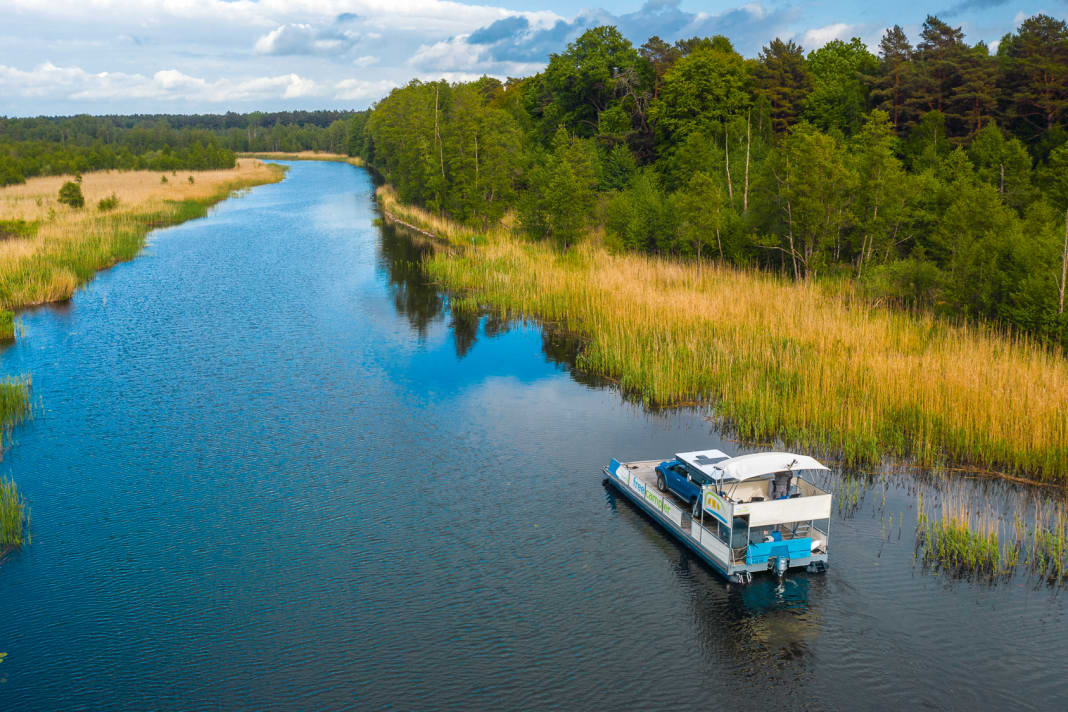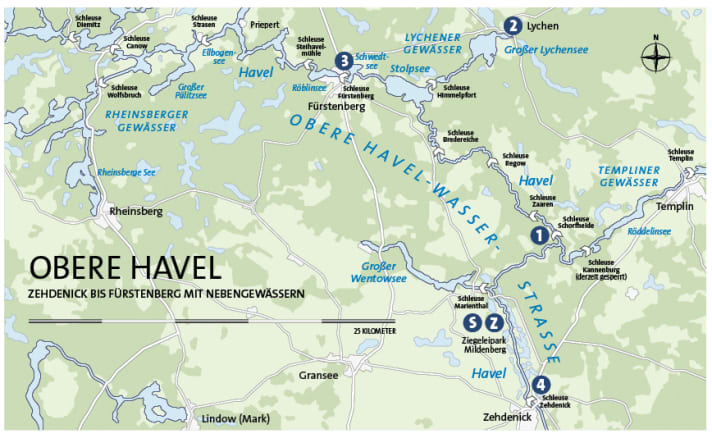





Slowly, centimetre by centimetre, the pick-up climbs the hill in front of Bredereiche. More and more nature appears on the horizon. There is a 2.2 metre difference in altitude to overcome, Brandenburg is a different calibre than Friesland. You have to work hard for every metre here. Then the lock gate opens and the journey can continue. "Freeda" chugs slowly out of the chamber towards the north. The day's destination is still hours away, the five kilometres on the speedometer still have to be subtracted from the counter-current, the many twists and turns of the Havel. What would be a short tour by bike becomes an extended day trip with "Freeda". Off-road on the Havel is a completely new experience in many respects.
The Tom Sawyer and Huckleberry Finn moment
At 334 kilometres long, the Havel is almost exactly ten times shorter than the Mississippi, but that's enough to make you feel like Tom Sawyer and Huckleberry Finn: After all, at five kilometres per hour, it would still take over two months to travel from the source to the mouth, and "Freeda" is no faster. "Freeda" (and her eight sisters) is a motorised raft, just big enough to accommodate a camper with a total weight of up to four tonnes. An outboard motor at the stern, plus a steering position, a tank and two anchors, and the charter adventure of a different kind is complete.
Well, Huck and Jim didn't have it quite as comfortable on their journey, and the current of the Havel is much more leisurely than that of the Mississippi. But the starry sky, the freedom and the natural surroundings would certainly have appealed to Mark Twain. For part-time rafters, the trip starts at the old Zehdenick brickworks. Here, where the bricks that were used to build large parts of Berlin were fired at the beginning of the 20th century, Markus Frielinghaus has dedicated himself to a special project: He is turning motorhomes into houseboats.
Almost no more limits on the water for "Freeda"
They roll over a small ramp onto the wooden-covered pontoon, and tension belts on the wheels hold the campers in place. If the Mitsubishi had previously set sail at a water depth of 80 centimetres, there are now almost no limits for our car on the water - after all, the Havel is part of Europe's largest contiguous area of inland waterways and lakes. A trip to Berlin is just as possible as a tour to the Müritz National Park. The best thing about it: the mooring guarantee is almost included, as you can anchor and moor anywhere outside of canals and fairways.
Once the car is on board, the engine is switched off. Instead, the 30 hp outboard motor bolted to the stern takes over and pushes the raft, which is over ten metres long, forward at a leisurely pace. The manoeuvring behaviour is similarly sluggish. Set the rudder, count to three and start counter-steering again in anticipation of the change of course. With every kilometre, the initial lurching course becomes straighter and the excitement decreases when oncoming traffic comes into view. Or a bend. Or both. In an emergency, a bow thruster helps to push the bow in the right direction, but that makes noise and disturbs the idyll. So you practise manoeuvring better and enjoy the nature that passes you by at walking pace. It is not uncommon for even a sheep on the bank to be faster than "Freeda".
Simply count the kilometres, allow for waiting times at locks - and you're done
The waterway map has markings for every kilometre of the river; if you haven't been paying attention, you can also use the kilometre markers on the banks to find out where you are. Wonderfully analogue navigation, without any GPS or digital map material. Planning the trip is just as simple: just count the kilometres, plan waiting times at locks and you're done. The Zehdenick brickworks is not even out of sight, and you are already more relaxed than ever before. It's quite possible that the steady lapping of the bow is contributing to this. A grey heron stands in the reeds on the left, later a brook with young fish rustles near the bank, sometimes a well-camouflaged angler hides behind his camouflage tarp. The longest tributary of the Elbe is rich in eels, pike, carp and perch, and a day fishing licence is available from 15 euros. And if the flame comes from a gas cylinder, the catch can even be barbecued on "Freeda".
When the sun sets over the Havelland, the smooth surface of the water reflects the evening sky and you can hear the cranes calling from the meadow opposite, the 80 million inhabitants of Germany seem infinitely far away. Without mobile phone networks and light smog, but with roaring deer in the undergrowth and hooting owls in the pines - even eagle owls now feel at home in the region again. No wonder, as they are considered to be birds with an affinity for water.
With a draught of just over half a metre, "Freeda" can anchor directly close to the shore
So where better to live than in the forests of the Havelland? With a draught of just over half a metre, "Freeda" can anchor close to the shore to be particularly close to nature. The only important thing is to keep an eye on the prevailing wind and take it into account when choosing the anchorage. In the best case scenario, it blows offshore and a bay offers protection on two or better three sides. If it is blowing onshore, an anchor without a foothold, a "slipping" anchor, could push the boat onto the shore. "We therefore only recommend anchoring to more experienced people," says Markus Frielinghaus. Shipwreck with an off-roader would be a very bizarre holiday memory.
The fact that Havelland is becoming an increasingly popular holiday region is evident in high season. This is when the canals and lakes get crowded, berths in harbours become scarce and waiting times increase at the numerous locks. Then the idyll is over and the fascination of the Havel off-road tour is drowned out by the noise of engines and the manoeuvring of holidaymakers. The low season is completely different: in April and October, the area unfolds its very own charm. Shore excursions round off the raft tour perfectly. Just don't be surprised if, after a short tour on your bike, you pedal past place names that are two days' journey away - if you want to explore further afield, we recommend a means of transport other than the "Freeda".
In principle, a trip to the Müritz with "Freeda" would also be possible
In addition to nature, which reveals itself above all from the waterside, there are also other little gems scattered throughout the region. The lovingly restored Fürstenberg, for example, the more splendid Rheinsberg and the town of Oranienburg, the first urban foothills of the capital. Those who prefer to unwind with a view of the lake can steer "Freeda" towards the waters of Templin or the lakes south of Neustrelitz. In principle, a trip to the Müritz would also be possible, but the raft feels more comfortable on the small, narrow waters than where the fresh westerly wind can get in the way of the skipper. After all, a campervan like this has a considerable wind attack surface that needs to be tamed. And higher swell is not necessarily "Freeda's" favourite discipline.
A map is recommended
When cruising through the country, it is also always advisable to have a map to hand, as you can regularly discover camper pitches on land from the water that will make the off-roader's heart beat faster. Time and again, forest paths and tracks are not closed to car traffic, so you can head for the sites with a clear conscience as soon as the car has solid ground under its wheels again at the end of the trip. This makes a Havel off-road tour on water and on land doubly exciting: first explore the region at a gentle pace, then kick up a little dust.
The temptation to simply moor "Freeda" on the shore in between to unload the car and go exploring on land is great, but neither possible nor permitted. However, with every kilometre along the river, the anticipation of spending another night with a view of the lake after the end of the trip grows - but this time from the shore. And for those who can't tear themselves away: The "Wilde Heimat" nature campsite still offers the degree of freedom that has made camping so endearing. And for those who are too afraid of water to entrust their camper to "Freeda": There are also canoes to explore the Havel without a car. But that would only be half the adventure.
Service

Cruise stages
S Mildenberg Brickworks Park - Schorfheide lock: 11 km
- Schorfheide-Lychen lock: 30 km
- Lychen- Fürstenberg: 14 km
- Fürstenberg- Zehdenick: 43 km
- Zehdenick - Mildenberg Brickworks Park: 6 km
S Mildenberg Brickworks Park
Total distance: 104 km
The TOP 3 in the district
- The Havel between the lock and Stolpsee is one of the most beautiful stretches of inland water in Germany. Marvellous nature with narrow bends through forests and meadows
- Fürstenberg, surrounded by lakes and with the Havel flowing through it, rightly bears its name "water town": several mooring facilities, many restaurants, good supply
- With its wooded shore, many bays and excellent water quality, the Großer Lychensee invites you to stop off, anchor, swim and fish (don't forget your fishing licence).
Literature
Cruising guide "From Berlin to Müritz" by Bodo Müller. 96 p., numerous photos, 25 plans, hardcover, format 18 x 24.6 cm; ISBN 978-3-667-10440-3. 32.90 €. www.delius-klasing.de
Waterway charts "Binnenkarten Atlas 2: Mecklenburgische Seenplatte". 31 maps, 24 detailed maps, spiral-bound, form. A3; ISBN 978-3-944082-14-1. 39,90 €. www.kartenwerft.de
OUR BOAT: Freecamper (pontoon catamaran; size for caravans) - length: 11.80 m - width: 3.95 m - draught: 0.60 m - height: 3.60 m - maximum permissible weight of loaded vehicle: 2200 kg - maximum possible length: 8.67 m - motorisation: 30 hp (outboard motor) - weekly prices: 690-1490 euros.
CHARTER: We were travelling with a Freecamper from Freecamper Boot & Camping, which offers its boats in four different performance classes (small caravans, motorhomes, camper vans and motorhomes). From the base in the new harbour of the Mildenberg Brickworks Park on the Upper Havel Waterway (North Brandenburg), trips can be made through the Uckermark, further north to the Mecklenburg Lake District or south (Oranienburg, Berlin), depending on the duration of the trip. Contact: Freecamper Boot & Camping, Dorfstraße 1, 17207 Südmüritz, Tel. 039923-716 26. www.freecamper.de
OUR CAR: Mitsubishi L200 (pick-up) - Length: 5.30 m - Width: 1.81 m - Height: 1.78 m (without attachment) - Unladen weight: 2100 kg - Engine: 181 hp (diesel)
Nautical information
THE REVIER The Upper Havel Waterway is part of the interconnected network of the Mecklenburg, Märkisch and Berlin waters, the largest contiguous water sports area in Europe. Almost the entire area is subject to the charter licence regulation, which allows you to operate a charter boat for the duration of the rental period without a pleasure craft licence after appropriate instruction. Exception: waterways used by commercial shipping in the greater Berlin area. In the charter licence area, however, holidaymakers are largely among themselves.
The infrastructure is very good and navigation is unproblematic. However, vehicles with limited manoeuvrability must take particular care on narrow and confusing sections (forest, bends). Almost all locks have now been converted to semi-automatic self-service operation. Waiting points are available, but in the main season, especially in the area of the lake district, longer waiting times of up to several hours must be expected at key points.

